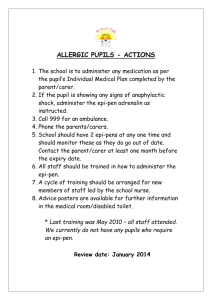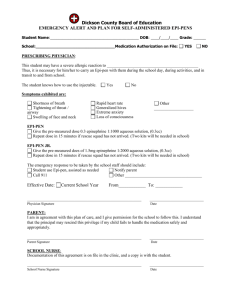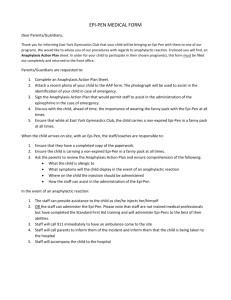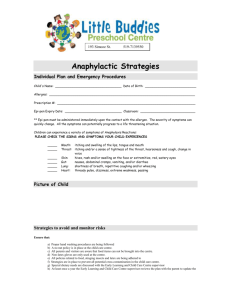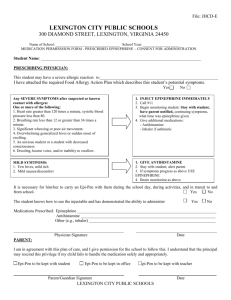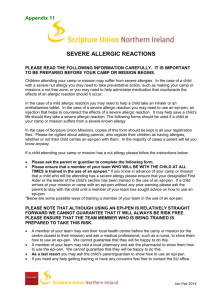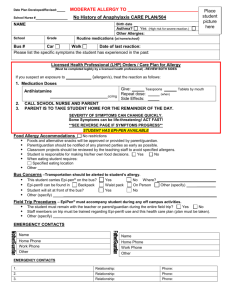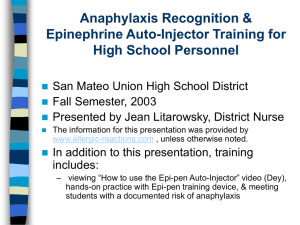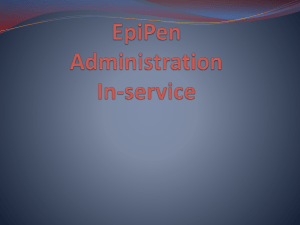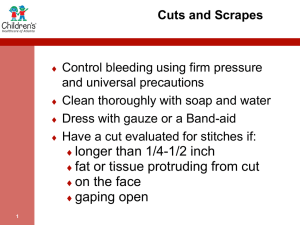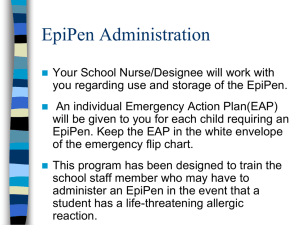managing life threatening allergies in school
advertisement
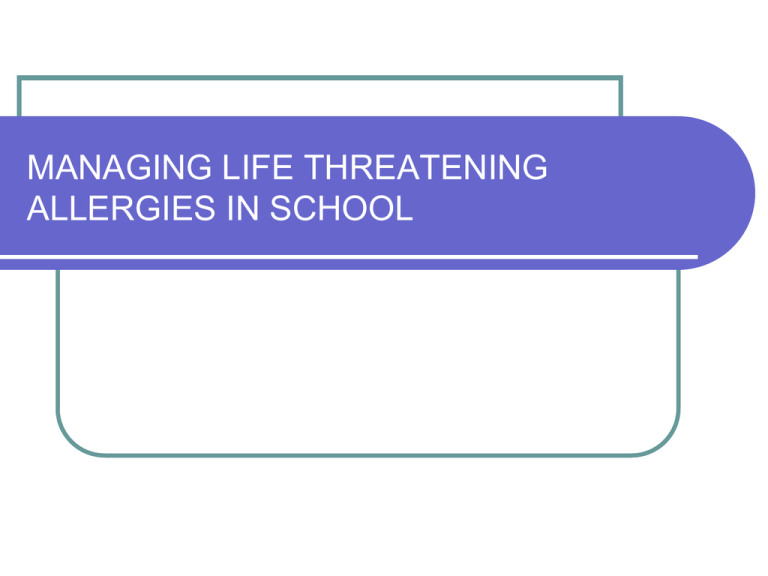
MANAGING LIFE THREATENING ALLERGIES IN SCHOOL •What is anaphylaxis? Anaphylaxis is a severe form of allergic reaction Anaphylactic shock can be life threatening Anaphylactic Symptoms Hives Difficulty Swallowing Wheezing Shortness of Breath Itching (of any part of the body) Swelling (of any part of the body) Vomiting Anaphylactic Symptoms Stomach Cramps Diarrhea Dizziness Fainting or loss of consciousness Flushed, pale skin, blue lips and mouth Sense of doom Causes of Allergic Emergencies Injections of medication or vaccine (penicillin, iodine or tetanus antitoxin) Insect bites and stings (bees, yellow jackets, wasps) Foods (i.e. peanuts, seafood, milk, eggs) Latex Exposure to cold temperatures Prevention Identify students with life-threatening allergies Avoid contact with allergens (peanut free zones) Read food labels Check playground equipment for bees nests, playing fields for yellow jackets Avoid products with latex (balloons, gloves) Prevention Develop allergy action plans for children with known life threatening allergies Train staff to respond when exposure to allergens happens Responding to an allergy emergency Someone should stay with the child Someone should notify the school nurse If the nurse is not available, staff trained in Epi-Pen® administration should be called Assess the emergency at hand Remove other students from area Identify allergic reaction Has student been exposed to allergen? Is student having symptoms of an allergic reaction? A serious reaction can develop in a few minutes or up to two hours following exposure to the allergen. Activate Emergency Response Whenever you suspect a life threatening allergic response, CALL 911 immediately Trained staff administer Epi-Pen® Parents/guardians of student are to be notified Notify administration How Epinephrine Works Constricts blood vessels Relaxes smooth muscles in lungs to improve breathing Stimulates heartbeat Works to reverse hives and swelling around face and lips How to administer EpiPen Make sure you have the right student Make sure you have the right medicine Make sure you have the right dose (EpiPens® come in two doses; 0.15 mg for individuals up to 66 pounds and 0.3 mg for individuals 66 pounds or over) Make sure to administer in the right place (outer thigh) How to administer the EpiPen Make sure to administer at the right time (student exposed to allergen and has symptoms of allergic reaction) When in doubt better to give Epi-Pen® Check expiration date on Epi-Pen® Check that color of liquid is clear Check that red flag is not in auto-injector window Directions for use of Epi-Pen® Unscrew cap of carrying case and remove Epi-Pen® Grasp Epi-Pen® with black tip facing downward (keep black tip away from hand and fingers) With other hand, remove gray safety cap Hold Epi-Pen® with black tip near thigh Jab firmly into thigh at a 90 degree angle Directions for use of EpiPen Epi-Pen® is designed to penetrate clothing Hold Epi-Pen® firmly against thigh to the count of 10 Remove Epi-Pen® from thigh and massage area for 10 seconds If 911 emergency services have not yet been called, CALL 911 Check that red flag appears in window Directions for use of Epi-Pen® Return used Epi-Pen® to plastic carrying case (avoid contact with needle) When EMS arrive, give them the used Epi-Pen® Copy of emergency card given to EMS If parents/guardians unavailable, staff person will accompany child to ER and stay until parent/guardian arrives. WARNING!!! NEVER put thumb, fingers or hand over exposed black tip of Epi-Pen® Accidental injection in hands or feet results in loss of blood flow to these areas If this happens, go to nearest ER immediately!!! DO NOT REMOVE GRAY SAFETY CAP UNTIL READY TO USE Directions for use of Epi-Pen® Effects of injection begin to wear off in 10 to 20 minutes It is critical to call for EMS if administer epinephrine In approximately 1/3 of anaphylactic reactions a delayed wave of symptoms follows 2 to 4 hours later This is called a biphasic reaction Care & Storage of Epi-Pens® Store in a place that is readily accessible by authorized persons, including the student’s person if appropriate Store between 59 – 86 degrees Fahrenheit (no extreme heat or cold) Protect from light Solution in Epi-Pen® should be clear in color Liability Mass. General Laws Chapter 71, Section 55 A: No public school teacher or collaborative school teacher, no principal, secretary to the principal, nurse or collaborative school employee who in good faith renders first aid or transportation to a student who has become injured or incapacitated in a public school building or on the grounds thereof shall be liable in a suit for damages as a result of his acts or omissions either for such first aid or as a result of providing emergency transportation to a place of safety, nor shall such person be Liability (cont’d) liable to a hospital for its expenses if under such emergency conditions he causes the admission of such injured or incapacitated student, nor shall he be subject to any disciplinary action by the school committee, or collaborative board of such collaborative for such emergency first aid or transportation. Documentation Diagnosis by physician that child is at risk of life-threatening allergy Written authorization by parent/guardian When administer epinephrine immediate notification of EMS Notification of parent/guardian Notification of school nurse/child’s physician Submit written report to Department of Public Health Questions?
